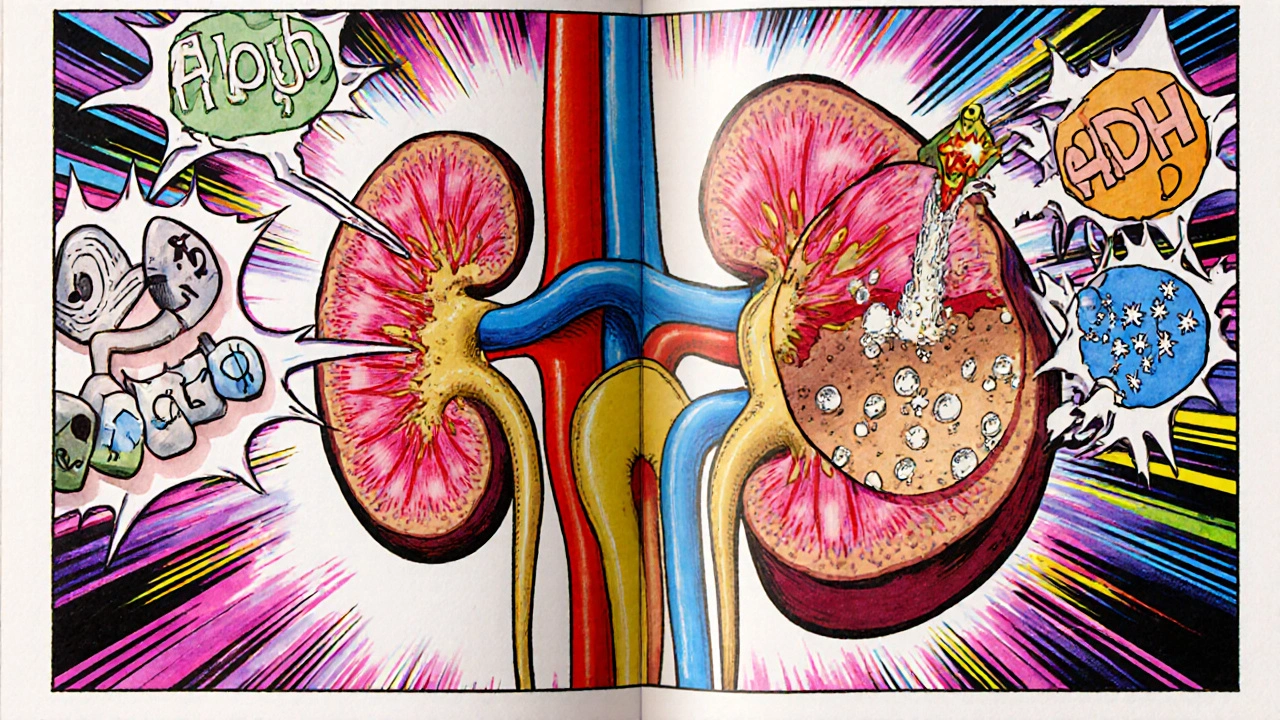Hormonal Fluid Retention Estimator
How Hormones Affect Your Fluid Balance
This tool estimates your potential fluid retention based on hormonal influences, stress levels, and daily habits. Enter your values to see how much extra water your body might be holding.
Estimated Fluid Retention
Based on hormonal factorsEver wonder why your ankles swell after a long flight or why you feel bloated before your period? The culprit is often not just salt or sitting still - it’s the hormonal signals that tell your body to hold on to water. This article breaks down which hormones are behind fluid build‑up, how they work, and what you can do to keep the extra pounds off.
What are Hormones?
Hormones are chemical messengers secreted by glands that travel through the bloodstream to tell organs what to do. Think of them as text messages that tell your kidneys whether to keep or release water, your blood vessels how tight to stay, and even your brain how thirsty you feel. The balance is delicate - a slight shift can tip the scales toward swelling.
Understanding Fluid Retention
Fluid retention (also called edema) is the accumulation of excess water in the body’s tissues, especially in the lower legs, abdomen, and hands. While a little extra fluid is normal after exercise, persistent swelling often signals that hormone‑controlled pathways are out of whack.
How Hormones Regulate Water Balance
The body relies on three core systems to manage water:
- Kidney filtration: Removes waste and decides how much water to return to the bloodstream.
- Blood pressure control: Determines how forcefully blood pushes fluid out of capillaries.
- Osmoregulation: Balances salt (sodium) and water concentrations.
Hormones act as the conductors for these systems. When they signal the kidneys to re‑absorb sodium, water follows - leading to higher blood volume and, eventually, swelling.
Key Hormones That Drive Retention
Aldosterone
Aldosterone, produced by the adrenal cortex, is the powerhouse behind sodium retention. It tells the distal tubules of the kidney to pull sodium back into the blood. Because water sticks to sodium, more water stays in circulation, raising blood pressure and often causing ankle or facial puffiness. Conditions like primary hyperaldosteronism can make this effect chronic.
Antidiuretic Hormone (ADH)
Also known as vasopressin, ADH is released from the pituitary gland when the body senses low water levels. ADH makes the collecting ducts in the kidney more permeable to water, so more water is re‑absorbed and less urine is produced. Over‑production, as seen in the syndrome of inappropriate ADH secretion (SIADH), leads to low sodium blood levels (hyponatremia) and noticeable bloating.
Estrogen and Progesterone
Women experience hormone‑related fluid shifts every month. Rising estrogen in the first half of the menstrual cycle boosts renin‑angiotensin activity, which indirectly raises aldosterone. Progesterone, dominant in the second half, has a mild diuretic effect, but the overall cycle still creates a net‑increase in water retention, especially before menstruation.
Cortisol
Stress‑induced cortisol spikes can stimulate both aldosterone release and ADH secretion. Chronic stress therefore often shows up as a puffy face and stubborn belly bloat, even if diet hasn’t changed.

The Kidney‑Sodium‑Hormone Triangle
The kidneys sit at the crossroads of these hormonal signals. Here’s a quick flow:
- Hormone (e.g., aldosterone) binds to receptors on renal tubule cells.
- Transport proteins increase sodium re‑absorption.
- Water follows sodium osmotically, expanding blood volume.
- Higher blood volume raises capillary pressure, pushing fluid into surrounding tissue - the classic “puffy” feeling.
Understanding this loop helps explain why a simple salt‑restriction diet can sometimes feel like a miracle.
Symptoms That Hint at Hormonal Retention
- Swelling in feet, ankles, or hands that worsens by evening.
- Weight gain of 1‑3kg over a few days without changes in eating.
- Feeling of tight clothing or shoes.
- Low‑grade fatigue - the extra fluid makes your heart work harder.
- In women, bloating that peaks a few days before menstruation.
If these signs appear alongside high blood pressure, persistent headaches, or sudden changes in urine output, a hormonal cause should be investigated.
Managing Hormone‑Driven Fluid Retention
Medical Interventions
- Aldosterone blockers: Spironolactone or eplerenone reduce sodium re‑absorption.
- ADH antagonists: Tolvaptan helps in SIADH cases by promoting water excretion.
- Hormone therapy adjustments: For women on birth control, switching to a lower‑estrogen formulation can lessen pre‑menstrual bloating.
- Stress management: Cortisol‑lowering strategies (mindfulness, adequate sleep) indirectly cut fluid retention.
Lifestyle Tweaks
- Limit sodium to 1,500mg per day if you’re sensitive to aldosterone.
- Stay active - walking lifts fluid out of the legs via muscle pumps.
- Hydrate wisely: drinking enough water reduces ADH spikes caused by dehydration.
- Elevate swollen limbs for 15‑20minutes a few times daily.

Quick Comparison of Major Hormones
| Hormone | Primary Action | Typical Retention Effect |
|---|---|---|
| Aldosterone | Increases Na⁺ re‑absorption in distal tubules | High - pronounced peripheral edema |
| ADH (Vasopressin) | Enhances water permeability in collecting ducts | Moderate - can cause generalized bloating |
| Estrogen | Up‑regulates renin‑angiotensin‑aldosterone system | Low‑to‑moderate - cyclical pre‑menstrual swelling |
| Progesterone | Acts as a mild natriuretic (sodium‑losing) agent | Low - may offset some estrogen effects |
| Cortisol | Stimulates both aldosterone and ADH release | Variable - stress‑related puffiness |
Checklist: Keep Hormone‑Related Retention in Check
- Track daily sodium intake; aim for ≤1,500mg if edema persists.
- Note timing of swelling - does it align with menstrual phases or stress peaks?
- Monitor blood pressure weekly; rising numbers often accompany excess fluid.
- Stay active for at least 30minutes most days.
- Discuss medication side‑effects (e.g., certain antidepressants) with your doctor.
Frequently Asked Questions
Can drinking more water actually reduce fluid retention?
Yes. Adequate hydration lowers ADH secretion, prompting the kidneys to excrete more water. The key is to avoid large gaps between drinks, which trigger the body’s ‘hold‑on‑to‑water’ reflex.
Is swelling after a long flight just a circulation issue?
Partly. Prolonged sitting reduces muscle‑pump action, allowing fluid to pool. However, low cabin humidity can also trigger ADH release, compounding the swelling.
Do birth control pills cause fluid retention?
Combined pills contain estrogen, which can mildly activate the renin‑angiotensin system, leading to slight water retention. Switching to a low‑estrogen or progestin‑only pill often eases the symptom.
When should I see a doctor for swelling?
If edema appears suddenly, spreads rapidly, is accompanied by shortness of breath, or you notice a sudden weight gain over 2‑3kg, seek medical attention. These could signal heart, kidney, or severe hormonal disorders.
Understanding the hormonal orchestra behind fluid retention empowers you to spot the warning signs early and take precise action-whether that means adjusting your diet, tweaking medication, or simply moving more. The next time you feel “puffy,” you’ll know exactly which messenger to check.






Comments
Taryn Esses
16/Oct/2025Hormones really do a lot more than just tell us when we’re hungry; they can also make our ankles puff up after a flight.
yogesh Bhati
16/Oct/2025When you think about the body’s fluid balance, it’s like a tiny universe where each hormone is a planet pulling the tides of water. Aldosterone is the heavyweight champion, forcing sodium to hang on tightly, and water follows like a loyal sidekick. ADH, on the other hand, is the sneaky whisperer that tells the kidneys to hold onto every drop when you’re dehydrated. Even estrogen can tip the scales by nudging the renin‑angiotensin system into overdrive, which is why many women notice extra puffiness before their periods. Cortisol is the stress‑induced alarm that amplifies both of these messages, turning a mild retention into a full‑blown swelling festival. The key is that these hormones don’t act in isolation; they form a chorus that can either harmonize or create chaos in your blood vessels.
Jeremy Wolfe
16/Oct/2025Think of your kidneys as the coach of a sports team; if the hormonal playbook tells them to retain sodium, they’ll keep the water in the locker room, leading to that dreaded ankle puff. A simple fix is to add a daily walk – the muscle pumps act like a secondary coach, flushing excess fluid back into circulation. If you’re on a low‑sodium diet and still feel bloated, consider checking your stress levels because cortisol can sabotage even the best diet plan. Staying hydrated actually helps; it signals the body that there’s no need for a water‑holding emergency.
Dan McHugh
16/Oct/2025Looks like another boring medical blog.
Sam Moss
16/Oct/2025Let’s unpack this hormonal orchestra piece by piece, because understanding the nuances can turn a frustrating "puffy" feeling into a manageable part of life.
First, aldosterone isn’t just a villain; it’s essential for maintaining blood pressure, but when it goes into overdrive – as in primary hyperaldosteronism – the sodium re‑absorption becomes a runaway train, and water hitchhikes along, swelling the lower extremities.
Second, ADH (vasopressin) is the body’s water‑saving mechanic. In a state of dehydration, it rightly tells the kidneys to hold onto water, but chronic over‑production, such as in SIADH, results in hyponatremia and a generalized bloated sensation that can feel like a balloon that won’t deflate.
Third, the menstrual cycle brings a cyclical rhythm of estrogen and progesterone. Early‑cycle estrogen spikes subtly crank up the renin‑angiotensin‑aldosterone system, nudging the kidneys to retain more sodium and therefore more water. Progesterone, which rises later, has a mild diuretic effect, but the net balance often leans toward retention just before menstruation, which explains that notorious pre‑period “knot” in the belly.
Fourth, cortisol – the stress hormone – is a double‑edged sword. Short‑term spikes help us survive acute stress by conserving fluid, yet chronic elevation fuels both aldosterone and ADH, creating a perfect storm of puffiness, especially around the face and midsection.
Fifth, let’s not forget the mechanical side: prolonged sitting or immobility impairs the muscle‑pump that normally shoves fluid from the legs back to the heart. Combine that with cabin‑dry air on flights, and you have a recipe for ankle edema even if your diet is perfect.
Now, for practical management: limiting sodium to around 1,500 mg per day can blunt aldosterone’s impact, but it’s equally important to stay well‑hydrated – paradoxically, drinking enough water suppresses ADH release, encouraging the kidneys to excrete the excess.
Exercise, especially walking or light resistance training, activates the calf muscle pump, nudging fluid out of the interstitial spaces. Elevating the legs for 15‑20 minutes a few times daily adds a mechanical shortcut for the circulatory system.
Medical options exist when lifestyle tweaks aren’t enough. Aldosterone antagonists like spironolactone or eplerenone directly block the sodium‑reabsorption pathway, while ADH antagonists such as tolvaptan are reserved for severe SIADH cases. Hormone therapy adjustments – for instance, switching to a lower‑estrogen birth‑control formulation – can also alleviate menstrual‑related swelling.
Finally, keep a simple log: note daily sodium intake, hydration timing, stress peaks, and any swelling patterns. This data helps you and your healthcare provider pinpoint which hormonal player is the main culprit and tailor interventions accordingly.
Suzy Stewart
16/Oct/2025Great breakdown! 🎉 Your tips on staying hydrated and using the calf pump are exactly what I needed. 👟💧
Melissa Young
16/Oct/2025Yo, that hormone jargon is straight fire – especially the bit on cortisol’s dual‑axis amplification. Can’t forget the neuro‑endocrine feedback loops when you’re optimising performance metrics.
Traven West
16/Oct/2025Drama alert: the kidneys are the real villains, and aldosterone is the mastermind pulling the strings!
Jonny Arruda
16/Oct/2025I hear you on the stress factor; taking a few minutes to breathe deep really does help the body dial back cortisol and, in turn, the water retention.
Steph Hooton
16/Oct/2025Thank you for sharing this thorough review; it provides an excellent framework for both patients and clinicians to address hormonal fluid retention in a systematic manner.